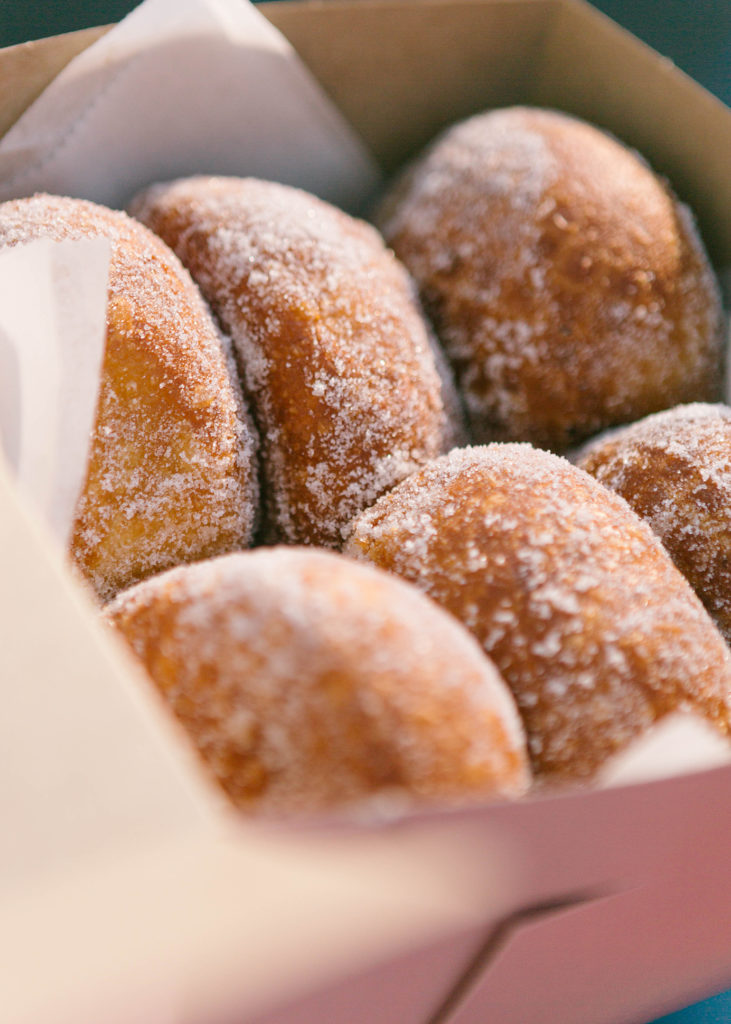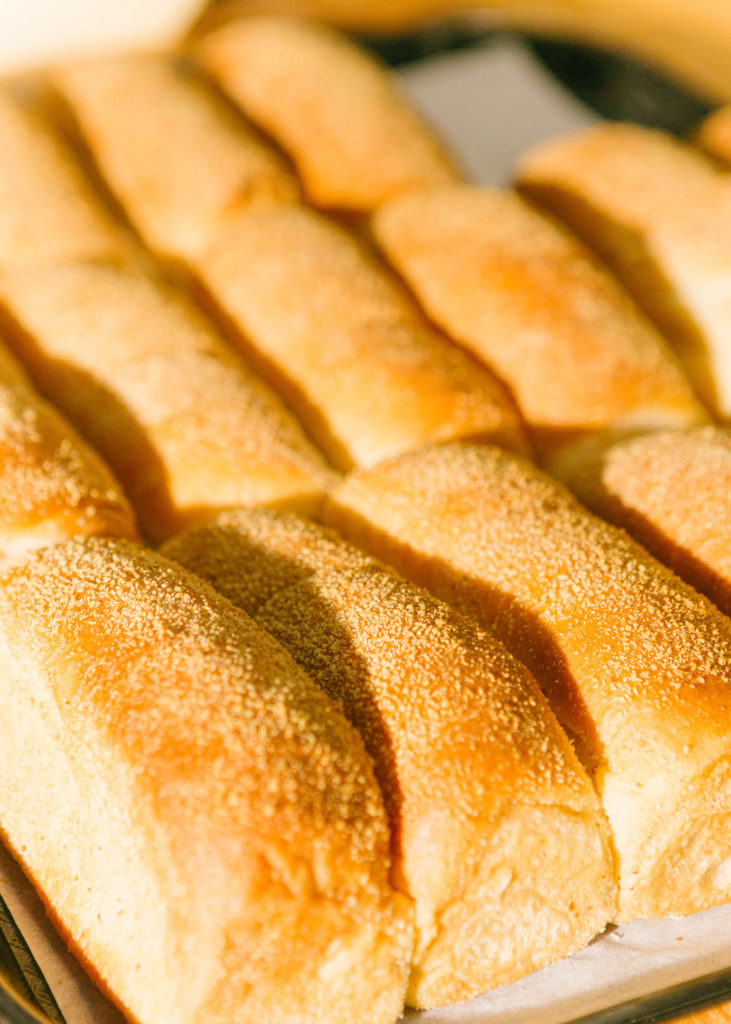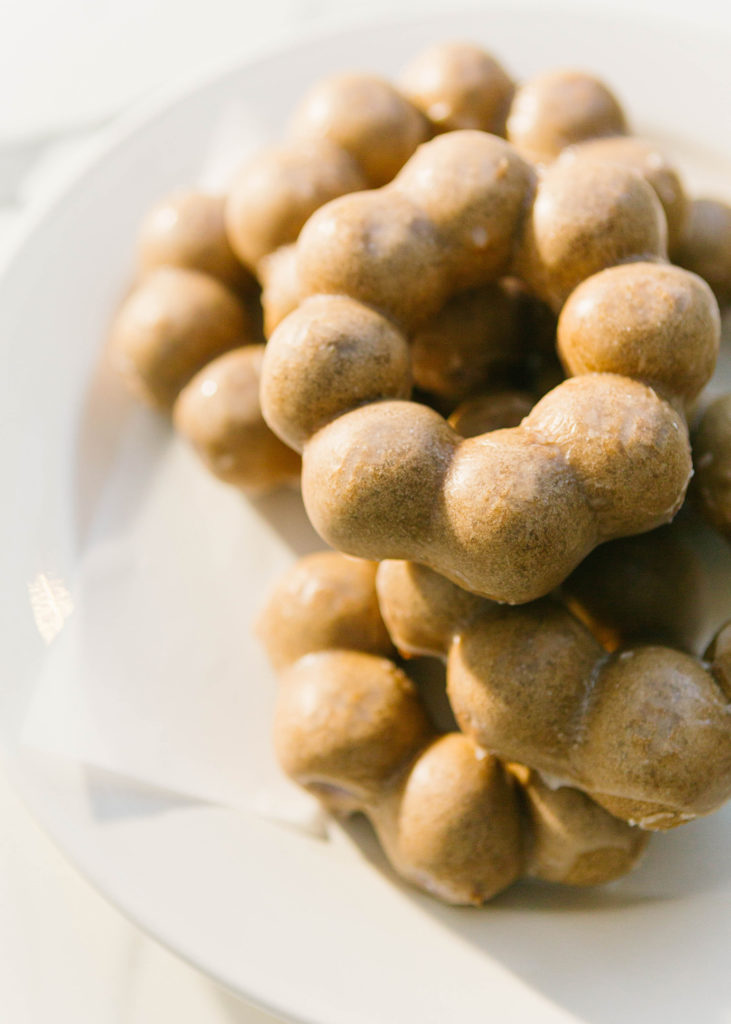Text by Kathleen Wong
Images by Lila Lee
The small fuchsia plastic bag is hot to the touch. I open it and a geyser of steam releases into the air. I eagerly reach my hand in, my fingertips grazing a fresh malasada dusted in sugar crystals. Taking the first bite, my teeth break through the deep-fried skin and sink into the fluffy, still-warm doughnut flesh. The pressure causes sweet haupia cream to gush out. It tastes like bliss.
Since I was young, a visit to Leonard’s Bakery has been a must-do whenever an out-of-towner visits, or if I’m feeling indulgent, or when I need some cheering up. Pre-pandemic, I’d wait in line near the shop’s small bake case, which showcases other treats like pao doce (sweet bread) and butter mochi. My sister would get a cinnamon sugar malasada, and my sweet tooth would drive me to the haupia-filled one.
If you look for malasadas in Honolulu, you’re guaranteed to come across Leonard’s Bakery, located on Kapahulu Avenue. Leonard Rego, the son of sugarcane plantation workers from São Miguel in the Azores, opened his namesake bakery in 1952, but it wasn’t until the following year that he added malasadas to the menu, crafting them using his grandparents’ recipe. Since then, Leonard’s Bakery has been a mainstay for malasadas in Hawai‘i.
For many locals, it’s hard to imagine a Hawai‘i without its beloved malasadas. And thanks to an influx of cultures that began in the plantation era and continues today, they’re one of many mouthwatering baked goods as uniquely multicultural as Hawai‘i itself. It doesn’t hurt that they’re all absolutely delicious.
Malasadas

It’s believed that Portuguese immigrants from the Madeira and Azores islands brought malasadas over in the late 1870s when they came to work on Hawai‘i’s sugar and pineapple plantations. These workers already had experience working with sugarcane back on their respective home islands.
In Portugal, the malasada has a cousin: a fried, globe-shaped doughnut called filhó. According to food historians, what separates the malasada from other doughnuts is its eggy dough made with evaporated milk, a departure from the typical yeast dough made with fresh milk.
Here in Hawai‘i, malasadas have adopted local flavors and ingredients, like the haupia- or guava-filled choices at Leonard’s. These doughnuts are often eaten on Mardi Gras or Fat Tuesday, also known as Malasada Day in Hawai‘i.
Spanish rolls

Soft and warm are the hallmarks of freshly baked bread, but Spanish rolls have an extra oomph—a subtle, buttery sweetness. It’s easy to lose count of how many crescent-shaped breads you’ve eaten in one sitting. Interestingly, Spanish rolls are a misnomer; they originally hail from the Philippines but can be traced to Spanish colonization of the islands in the 16th century.
The baked goods are similar to ensaymadas, another sweet bread from Mallorca, Spain, or the classic Filipino bread called pandesal. Filipinos adopted bread-making techniques from the Spanish, such as using salt and sugar, and made them their own.
Opened by Filipino immigrant Fernando H. Paez, Nanding’s Bakery remains the same small, unassuming panaderia (bakery) it has been for over 20 years. On O‘ahu, you can visit the bakery’s three locations, or you can find its signature Spanish rolls at 7-Elevens statewide.
For a modern, local spin on Spanish rolls, Beyond Pastry Studio in downtown Honolulu offers a mango-pineapple version.
“I like to bake what I grew up with, like pandesal and Spanish rolls with chicken adobo, because I want to share that happiness with other people,” says Cristina Nishioka, its Philippines-born owner and pastry chef. “I wanted to raise the standard and elevate Filipino pastries, and to give more options to a good, quality pastry.”
Mochi doughnut

Mochi is known for its sticky, chewy texture and ability to slowly revert to its original shape if you push your finger into its soft, pillowy surface. Mochi came to Hawai‘i from Japan by way of plantation workers in the 19th century. Since then, rice flour has become a popular replacement for wheat flour in local baked goods, giving the mochi versions a light, springy texture.
Inspired by Japan’s mochi donut craze, O‘ahu’s famed Liliha Bakery introduced the poi mochi donut in 2016. Entering Liliha’s bustling flagship location in Kalihi, I grab a number and wait for it to be called. As I wait, workers in white shirts and black aprons haul baking trays heavy with freshly baked doughnuts.
At Liliha Bakery, they deep-fry sweet rice flour mixed with fresh, locally made poi, or taro, to make the doughnut: eight glazed balls linked together in the shape of a ring. I gently pull the doughnut apart and admire the vibrant purple inside. I pop a purple doughnut ball into my mouth for a surprisingly delicate treat.
Kouign-amann
While the plantation era had significant influences on Hawai‘i’s palate, cultures continue to borrow from each other today. Kouign-amann, pronounced “queen-a-mahn,” are flaky pastries that look like a mix between a croissant and a palmier.
Although the exact origins of the buttery pastry is a mystery, signs point to Finistère, the westernmost tip of the French region Brittany, also home to the galette. People from the Finistère town of Douarnenez have even formed a kouign-amann association to protect the integrity and heritage of the rustic pastry.
At Kona Coffee Purveyors’ B. Patisserie, which hails from San Francisco, the kouign-amann pastries come in tropical and Asian flavors. The pastry menu changes seasonally, based on what’s locally available, but expect flavors like guava coconut almond, coconut lychee, and black sesame.
“Our inspiration comes from the fruit of our land,” says Kona Coffee Purveyors co-founder Jacqueline Suiter.





